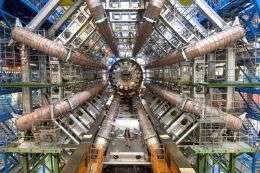September 1, 2008 feature
Physicists Rule Out the Production of Dangerous Black Holes at the LHC

(PhysOrg.com) -- On August 8, the world's largest particle accelerator, the Large Hadron Collider near Geneva, Switzerland, began the process of slowly throttling to full power. When its proton beams are circling at full speed and collisions begin, scientists from around the world will finally be able to start collecting data.
LHC collisions may reveal new clues about the origin of the universe, new particles, new dimensions, and perhaps even new physics even theory doesn't predict. But will the collisions be powerful enough to create a tiny mass of particles with a gravitational pull so strong it can "eat" other matter -- a microscopic black hole? And if yes, could such a thing grow big enough to swallow Earth itself?
The fact is, the LHC could produce a tiny, extremely short-lived (read: harmless) black hole. It is an unlikely event, but one that physicists are nonetheless excited about. However, they discount the possibility of a stable black hole -- one with the chance to grow into something worth worrying about -- as much more science fiction than science.
Recently, two physicists took a close, practical look at the issue by examining known astrophysical phenomena, using what scientists already know about the universe to determine the likelihood that the LHC will produce stable black holes on Earth.
The physicists are Steven Giddings, of the University of California-Santa Barbara, and Michelangelo Mangano, of the European Organization of Nuclear Research (CERN), which built the LHC. In their paper, published in the August 18, 2008, online edition of Physical Review D, they examine the "extremely hypothetical scenario" in which black holes are created at the LHC, are stable, and become trapped within the Earth. Would we be doomed? The short answer is no.
Giddings told PhysOrg.com, "We went to great pains to thoroughly investigate possible risk in even some very outlandish proposals for black hole behavior, and found we could safely rule it out. The basic reason is simple: Nature has been performing this type of experiment for billions of years, not only on our planet and sun, but also on much denser objects, like neutron stars and white dwarfs. Their enormous age reassures us that physics doesn't exhibit the bizarre behavior that LHC opponents have suggested."
Giddings and Mangano's first argument against stable LHC-produced black holes is the fact that scientists almost universally agree that black holes evaporate, emitting particles called Hawking radiation, named for Stephen Hawking, who proposed the phenomenon and showed why it exists. A microscopic black hole would thus be very unstable, disappearing in the tiniest fraction of a second.
They also remind us (in an argument presented in the past) that collisions with the same power as those to be produced at the LHC—in the trillion electron volt range—happen all the time on Earth, when cosmic rays from deep space (protons with extremely high energies) collide with molecules in the atmosphere. The quick, logical conclusion is that such events, if they could produce dangerous, stable black holes, would have already done so.
But Giddings and Mangano consider two scenarios that aren't quite so simple: if a stable black hole created in the atmosphere carried a charge, or if it was neutral.
They calculate that a charged black hole produced by cosmic rays wouldn't be able to travel very far before it was drained of energy by the material of the Earth, or if very energetic, by the Sun. If charged black holes have ever been produced in our atmosphere, our existence is proof they are safe. At the LHC, a black hole would likely be charged because it would have been produced by collisions between quark pairs (quarks have charge).
But if the black hole was neutral, and if it was also stable, emitting no Hawking radiation, that could be troubling. Giddings and Mangano examine this scenario despite that the likelihood of it occurring is almost zero, since scientists believe that neutralization could not occur without the emission of Hawking radiation. Neutralization and Hawking radiation are intricately linked quantum processes; if one is occurring, the other should be, too.
Over pages of analysis, they show that there are two possible cases of stable, neutral black holes. Which of these cases could be true depends on which physics theory of extra dimensions (there are competing theories) is correct.
The first case is the slow growth of a neutral, stable microscopic black hole. If such a black hole were produced on Earth as a result of LHC collisions, its growth would take place on a time scale longer than the natural life of our sun. That means our star would burn out before we were in danger.
This leaves the second case, of growth faster than the sun's lifetime. Such stable, neutral black holes would also be created by cosmic-ray collisions. Because of this, Giddings and Mangano's paper shows that much denser objects than Earth and the sun, such as white dwarfs and neutron stars, which are already close to collapsing in on themselves, would be destroyed by such black holes. The simple fact that these stars still exist excludes this second case.
That leaves the first case as the only possibility in the case of stable, neutral black holes. And as Giddings reminds us, "The overwhelming majority of the scientific community agrees that the stable scenarios are crazy anyway."
Citation: Phys. Rev. D 78, 035009 (2008)
Copyright 2008 PhysOrg.com.
All rights reserved. This material may not be published, broadcast, rewritten or redistributed in whole or part without the express written permission of PhysOrg.com.





















